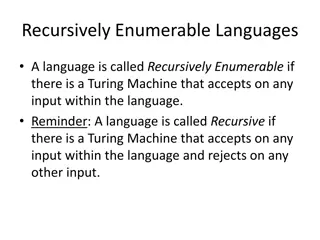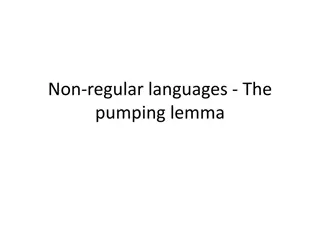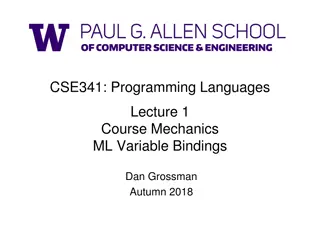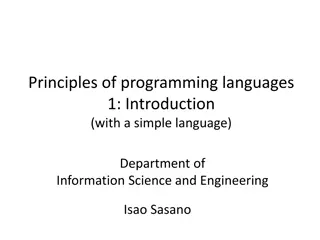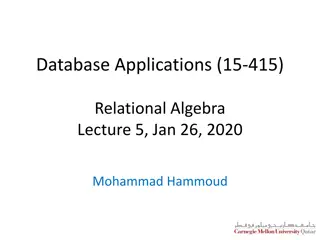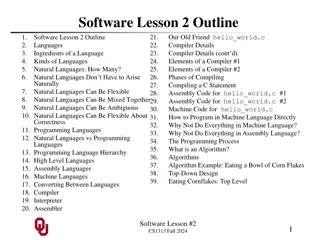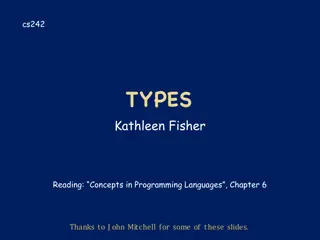Understanding LBI Macros in Programming Languages
Explore the concept of Language Being Implemented (LBI) Macros in programming languages through examples and explanations. Discover how macros extend language syntax and how to implement them using Racket as the metalanguage. See how LBI macros generate expressions and simplify evaluation processes.
Download Presentation

Please find below an Image/Link to download the presentation.
The content on the website is provided AS IS for your information and personal use only. It may not be sold, licensed, or shared on other websites without obtaining consent from the author. Download presentation by click this link. If you encounter any issues during the download, it is possible that the publisher has removed the file from their server.
E N D
Presentation Transcript
CSE 341 Section 7 Winter 2018 Adapted from slides by Eric Mullen, Nicholas Shahan, Dan Grossman, and Tam Dang
Outline LBI (Language Being Implemented) LBI Macros Eval, Quote, and Quasiquote Variable Number of Arguments Apply 2
LBI (Language Being Implemented) Yesterday in lecture, we saw we can define a Programming Language inside racket by structs We will talk about how to do evaluation on these LBIs tomorrow Show struct definition examples 3
Macros Review Extend language syntax (allow new constructs) Written in terms of existing syntax Expanded before language is actually interpreted or compiled 4
How to implement Macros in LBI Interpreting LBI using Racket as the metalanguage LBI is made up of Racket structs In Racket, these are just data types Why not write a Racket function that returns LBI ASTs? 5
LBI Macros If our LBI Macro is a Racket function (define (++ exp) (add (int 1) exp)) Then the LBI code (++ (int 7)) Expands to (add (int 1) (int 7)) 6
LBI Macros We are just generating expressions of LBI, so expressions in LBI are still composed of the original structs If we have an eval function, we don t need extra code to evaluate these macros 7
quote Syntactically, Racket statements can be thought of as lists of tokens (+ 3 4)is a plus sign , a 3 , and a 4 quote-ing a parenthesized expression produces a list of tokens 8
quote Examples (+ 3 4) ; 7 (quote (+ 3 4)) ; '(+ 3 4) (quote (+ 3 #t)) ; '(+ 3 #t) (+ 3 #t) ; Error You may also see the single quote character used as syntactic sugar 9
quasiquote Inserts evaluated tokens into a quote Convenient for generating dynamic token lists Use unquote to escape a quasiquote back to evaluated Racket code A quasiquote and quote are equivalent unless we use an unquote operation 10
quasiquote Examples (quasiquote (+ 3 (unquote(+ 2 2)))) ; '(+ 3 4) (quasiquote (string-append "I love CSE" (number->string (unquote (+ 3 338))))) ; '(string-append "I love CSE" (number->string 341)) You may also see the backtick ` character used as syntactic sugar for quasiquote The comma character , is used as syntactic sugar for unquote 11
Self Interpretation Many languages provide an eval function or something similar Performs interpretation or compilation at runtime Needs full language implementation during runtime It's useful, but there's usually a better way Makes analysis, debugging difficult 12
eval Racket's eval operates on lists of tokens Like those generated from quote and quasiquote Treat the input data as a program and evaluate it 13
eval examples (define quoted (quote (+ 3 4))) (eval quoted) ; 7 (define bad-quoted (quote (+ 3 #t))) (eval bad-quoted) ; Error (define qquoted (quasiquote (+ 3 (unquote(+ 2 2))))) (eval qquoted) ; 7 (define big-qquoted (quasiquote (string-append "I love CSE" (number->string (unquote (+ 3 338)))))) (eval big-qquoted) ; I love CSE341 14
Variable Number of Arguments Some functions (like +) can take a variable number of arguments There is syntax that lets you define your own (define fn-any (lambda xs ; any number of args (print xs))) (define fn-1-or-more (lambda (a . xs) ; at least 1 arg (begin (print a) (print xs)))) (define fn-2-or-more (lambda (a b . xs) ; at least 2 args (begin (print a) (print b) (print xs)))) 16
apply Applies a list of values as the arguments to a function in order by position (define fn-any (lambda xs ; any number of args (print xs))) (apply fn-any (list 1 2 3 4)) (apply + (list 1 2 3 4)) ; 10 (apply max (list 1 2 3 4)) ; 4 17







